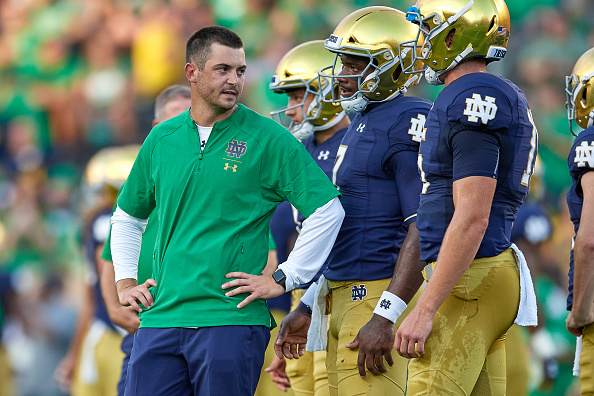Tommy Rees has been an oft-criticized figure during his time at Notre Dame. When he was a player, he garnered the unfortunate moniker “Tommy Turnover” with 37 career interceptions. Now, Rees has taken over the offensive playcalling duties for the Irish. And, again, he remains frequently scrutinized. After the Irish scored just 10 points against Ohio State in a contest that even an average offensive performance would have won, the critics reached an all-time high in volume. So, looking back at last week, how much of the offensive performance can be attributed to Tommy Rees?
Was Tommy Rees Too Conservative?
Against Ohio State, it’s an interesting question. Irish fans expressed a lot of concern about head coach Marcus Freeman’s comments regarding ‘game control’ and not trying to go ‘score for score’ with the Buckeyes. But, realistically, that was the correct approach to the contest. Nobody anticipated the Irish giving up just 21 points. And no one in their right mind would have said Notre Dame’s best chance of victory would be matching up their largely unproven and inexperienced offense in a shootout versus Ohio State’s arsenal of Heisman contenders. Game control was the right call.
It is not on Rees that the offensive line could do very little against the Buckeyes’ defensive front. Running backs averaged 0.4 yards before contact. And with that, the Irish still managed 3.5 yards per carry (adjusted for sacks). From a playcalling standpoint, sometimes, it’s just not your day on the ground. With Notre Dame missing All-American guard Jarrett Patterson and running back Logan Diggs playing only nine snaps, that was the case for Notre Dame.
First Drive
Now, there are moments, you could certainly argue, the Irish played it too safe. The first drive is certainly a prime example. After a 54-yard pass and 15-yard OSU penalty gave the Irish a red zone possession after just one play, Rees called three straight runs. The first down rush made sense and gained three yards. On 2nd and 7, running the ball is not an abhorrent decision.
The second rush was a read-option, and three Ohio State defenders had already worked their way free as the handoff was made. That negative play is on execution. But then on 3rd and 9, the play call seemed to be a quarterback run, or at the very least it turned into that. In a game, they had to score to win and to not even take a shot at the endzone while 15 yards out is certainly worthy of criticism. The field goal felt like less of a win, given how the drive started.
Rest of the First Half
The Irish were conservative on the second drive, but they also were backed up inside their own three-yard line. Maybe a downfield shot would be nice there, but playing to get some rushing yards and a chance on third down is not a bad call. The ultimate third-down conversion pass attempt came up a yard short. Conservative, but rather justifiably so. For the second three and out, credit the Ohio State defense. They made a 1-on-1 tackle against tight end Michael Mayer to hold him to no gain. And on third down, Tommy Eichenberg ran a well-disguised blitz, curling around through the A-gap to drill Tyler Buchner.
Another punt came after a seven-yard run on first down, a stuffed run, and an incompletion to Mayer. It was a good call that had Mayer isolated, but Buchner had to rush the throw under pressure. Ultimately, there was a lot to like in the first half. The Irish put 10 points on the board, and they frequently targeted Mayer, which was definitely key in their recipe for success.
2nd Half
Tommy Rees and the Irish offense got just four drives in the second half. Ohio State dominated the clock, so it makes it hard to judge on the small sample size. But, let’s look at what we did see. Their first drive started at their 43-yard line after an OSU penalty. Prime field position, and, up three points, Notre Dame needed to make a statement and put points on the board. Rees took a shot to Lorenzo Styles on the first play, and the call almost turned into six points. But Blake Fisher got beat around the edge, and Rees had to rush the throw, putting the pass just out of reach. The second play call was more play-action, and Buchner had his man, but again, he had to throw under duress and on the move. The ball was tipped and didn’t quite reach and open Jayden Thomas.
Unnecessary roughing extended the drive, however, and the offense stayed on the field. On the first down play, there should be some serious questions. The general concept is nice, with a pitch left to Audric Estime. But the Irish pulled Joe Alt and Andrew Kristofic across the line away from the play. The tight ends blocked the corners, but Eichenberg was completely unaccounted for and blew up what felt like a good call had the Irish had enough blockers. Second down represented more offensive line woes, as Buchner had to scramble to avoid a sack. On third down, the Irish faced a 3rd and 11 at the 36.
Split the blame on this play between Rees and Buchner. The Irish are certainly in four-down territory if they get 5-6 yards. They’re even on the fringe of field goal range. Instead, the Irish tried to convert all 11 yards in one play. Unclear who the first read on this play was, but Buchner actually had time in the pocket and tried to squeeze a ball into double pressure. Maybe the play call could be better there, but also not Buchner’s best decision.
The Final Blow
After Ohio State took the lead, Tommy Rees put the Irish in a position to answer immediately. A 32-yard pass to Braden Lenzy started the drive. Rees then dialed up a nice Chris Tyree sweep for 14 yards, and the Irish were at the Ohio State 41. Then, offensive pass interference backed the Irish up 15 yards. And Rees responded with three straight rush plays. In the fourth quarter, down by four points against the No. 2 team in the nation. Let’s break it down.
The first was a read-option, and Buchner kept it. He gained seven yards, and that play has produced big yardage before. Getting seven yards back on first down was not perfect, but far from the worst result. The second down call went back to the Tyree sweep. With two plays to get 18 yards, a pass would have been good here. Get the ball to a playmaker and get some positive yards to set up third down and manageable. Additionally, they had just run the Tyree sweep play, or at least a very similar variation of it, two plays prior. The blocking could have been better, but this play call was pretty low-ceiling as far as what it could’ve produced.
Then on 3rd and 18, Rees called for a quarterback draw. This was ultra-conservative in a big situation. Not taking a shot is fine, but call something with some potential in a third and long. On the draw, Tyree motioned out wide and had blockers for a potential screen pass. Instead, the Irish ran it up the middle for no gain.
The idea was to pin Ohio State and let the defense go to work. But the defense was too tired after being on the field for most of the second half, and the Buckeyes drove the nail into the coffin.
Grading Tommy Rees
This grade was calculated in a relatively straightforward manner. The Irish ran 48 plays on Saturday. I found eight plays in which I felt Rees dialed up a play call that wasn’t situationally correct. That’s good for an 83%, a solid B-. Looking at the two halves, however, does show an issue with the halftime adjustments. Seven of those eight poor plays came in the second half, where the margin for error was a lot smaller. Rees’ game plan felt really strong, but Ohio State minimized the damage, made plays, and then adjusted in a dominant fashion.
So ultimately, give Rees a B- for his first-week performance. You want to see better, but there were a lot of positives and a lot of good moments. Ultimately, the result tilted the Buckeyes’ way because of execution errors, not Tommy Rees. There’s a lot to work on in this upcoming week against Marshall, but don’t lose confidence in this young coaching staff.






